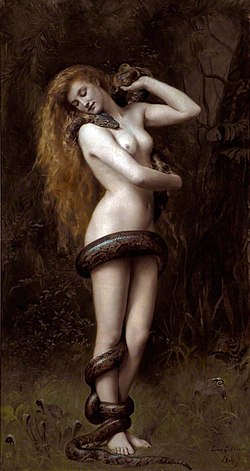User:Lilitu
| This is a Wikipedia user page. This is not an encyclopedia article or the talk page for an encyclopedia article. If you find this page on any site other than Wikipedia, you are viewing a mirror site. Be aware that the page may be outdated and that the user whom this page is about may have no personal affiliation with any site other than Wikipedia. The original page is located at https://en.wikipedia.org/wiki/User:Lilitu. |
- This article is about the demon Lilith. For other meanings of the word see Lilith (disambiguation).
In some kabbalistic texts, Lilith is a female demon, a succubus, who may have been Adam's first wife, before Eve. Because she would not accept subordination, she has become a symbol to many feminists, especially some Jewish women's groups.

Lilith in World myths[edit]
The original name in Sumerian was "Lilitu", and the transliteration from the Hebrew may be as "Lilith," "Lillith," or "Lilit". Various versions of the Lilith myth exist; the original Lilith was a Mesopotamian night demon with a penchant for destroying children.
Hieronymus associated Lilith with the mythical Greek Lamia, a Libyan queen who mated with Zeus. After Zeus abandoned Lamia, Hera stole Lamia's children, and Lamia took revenge by stealing other women's children.
Lilith in the Bible and other ancient texts[edit]
Lilith's name only appears once in the Old Testament at Isaiah 34:14-15, where it is translated as "great owl" in the King James Version of the Bible, leading to Lilith often being portrayed in imagery as an owl (this interpretation has been disputed).
However, some interpret the passage in Genesis 1:27: So God created man in his own image, in the image of God created he him; male and female created he them, before describing a mate being made of Adam's rib and being called Eve in Genesis 2:22, to mean that Adam had a wife before Eve, and that this could have been Lilith. However, this divergence is often explained as a careless weaving together of two discrete biblical creation myths, as the Bible describes man being created in both Genesis 1:26 and 2:27.
Lilith's name also appears in the Dead Sea Scrolls in passages that are based on the above-noted Isaiah reference, and in various places in the Talmud and the Zohar.
Lilith as Adam's first wife[edit]
The first clear reference to Lilith as the first wife of Adam is in an anonymous medieval work called 'The Alphabet of Ben-Sira'. In it, Lilith is described as refusing to assume a subservient role to Adam during sexual intercourse and eventually deserted Adam. Lilith then went on to mate with Asmodai and various other demons she found beside the Red Sea, creating countless lilin. Adam urged God to bring Lilith back, so three angels were despatched after her. When the angels, Senoy, Sansenoy, and Semangelof, made threats to kill one hundred of Lilith's demonic children for each day she stayed away, she countered that she would prey eternally upon the descendants of Adam and Eve, who could be saved only by invoking the names of the three angels, and did not return to Adam.
This story has similarities with the original Mesopotamian myth, where Lilith killed children, and so the practice of protecting children by placing Lilith amulets around their necks with the names of the three angels became a custom of many Jewish communities in medieval times.
This legend was mistakenly included in an English language book of rabbinic works (the author seemingly assumed that any ancient book read in the Jewish community must have been a rabbinic work). However, contrary to popular belief, the 'The Alphabet of Ben-Sira' is not a Jewish religious text; rather, it is a collection of perverse stories about heroes of the Bible and Talmud. Modern historians are unsure of its original purpose, although it may have been a collection of risqué folk-tales, a refutation of Christians, Karaites or other separatist movement, or simply an anti-Jewish satire.
